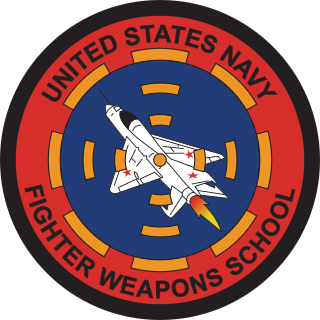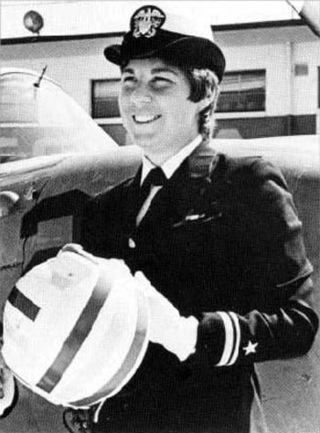
Manley Lanier "Sonny" Carter Jr., M.D., , was an American chemist, physician, professional soccer player, naval officer and aviator, test pilot, and NASA astronaut who flew on STS-33.

The Grumman F9F Panther is an early carrier-based jet fighter designed and produced by the American aircraft manufacturer Grumman. It was the first jet-powered fighter aircraft to see air-to-air combat with the United States Navy as well as being Grumman’s first jet fighter.

The Convair F2Y Sea Dart is an American seaplane fighter aircraft that rode on twin hydro-skis during takeoff and landing. It flew only as a prototype, and never entered mass production. It is the only seaplane to have exceeded the speed of sound.

The United States Navy Strike Fighter Tactics Instructor program, more popularly known as Top Gun, is a United States Navy training program that teaches air combat maneuvering tactics and techniques to selected naval aviators and naval flight officers, who return to their operating units as surrogate instructors.

Naval Air Station Pensacola or NAS Pensacola, "The Cradle of Naval Aviation", is a United States Navy base located next to Warrington, Florida, a community southwest of the Pensacola city limits. It is best known as the initial primary training base for all U.S. Navy, Marine Corps and Coast Guard officers pursuing designation as naval aviators and naval flight officers, the advanced training base for most naval flight officers, and as the home base for the United States Navy Flight Demonstration Squadron, the precision-flying team known as the Blue Angels.

The Grumman F3F is a biplane fighter aircraft produced by the Grumman aircraft for the United States Navy during the mid-1930s. Designed as an improvement on the F2F, it entered service in 1936 as the last biplane to be delivered to any American military air arm. It was retired from front line squadrons at the end of 1941 before it could serve in World War II, and replaced by the Brewster F2A Buffalo. The F3F, which inherited the Leroy Grumman-designed retractable main landing gear configuration first used on the Grumman FF, served as the basis for a biplane design ultimately developed into the much more successful F4F Wildcat that succeeded the subpar Buffalo.

William Patrick "Willy Irish" Driscoll is a retired commander in the United States Navy and a highly decorated flying ace.

A naval aviator is a commissioned officer or warrant officer qualified as a crewed aircraft pilot in the United States Navy or United States Marine Corps. United States Coast Guard crewed aircraft pilots are officially designated as "Coast Guard aviators", although they complete the same undergraduate flight training as Navy and Marine Corps crewed aircraft pilots, and are awarded the same aviation breast insignia.

A Weapon Systems Officer (WSO), nicknamed "Wizzo", is an air flight officer directly involved in all air operations and weapon systems of a military aircraft.

Training Squadron EIGHT SIX (VT-86), also known as the "Sabrehawks," is a United States Navy advanced jet training squadron based at the Naval Air Station Pensacola, Florida. Training Squadron 86 is a tenant command of Training Air Wing 6. They are a training squadron flying the T-45C Goshawk. Their tailcode is F and their radio callsign is ROKT.

Barbara Ann Allen Rainey was one of the first six female pilots in the U.S. armed forces. Rainey received her wings of gold as the first female to be designated a naval aviator in February 1974 and became the first Navy woman to qualify as a jet pilot. She attained the rank of Lieutenant Commander in the United States Navy. She was killed in an aircraft crash in 1982 while performing her duties as a flight instructor.

The United States Naval Aviation Hall of Honor, located at the National Naval Aviation Museum in Pensacola, Florida, recognizes individuals "who by their actions or achievements made outstanding contributions to Naval Aviation." Since its inception in 1979, the Hall of Honor has enshrined 80 people representing every element of the naval aviation family: U.S. Navy, U.S. Marine Corps, U.S. Coast Guard, Civilian and every naval aviation warfare community. Selectees are chosen by a board appointed by the Director, Air Warfare Division, Office of the Chief of Naval Operations, sponsor of the Hall of Honor, and approved by the Chief of Naval Operations.

Dive Bomber is a 1941 American aviation drama film directed by Michael Curtiz, and starring Errol Flynn, Fred MacMurray and Alexis Smith. It was produced and distributed by Warner Brothers. The film is notable for both its Technicolor photography of pre-World War II United States Navy aircraft and as a historical document of the U.S. in 1941. This includes the aircraft carrier USS Enterprise, one of the best-known U.S. warships of World War II.

Flight Command is a 1940 American U.S. Navy film from MGM, produced by Frank Borzage and directed by J. Walter Ruben and Frank Borzage (uncredited), starring Robert Taylor, Ruth Hussey, and Walter Pidgeon. It has the distinction of often being credited as the first Hollywood film glorifying the American military to be released after the outbreak of World War II in Europe, a year before the U.S. entered the conflict.
The US Navy had four programs for the training of naval aviators.

Lt. James Albert Whitted, was an American aviator from St. Petersburg, Florida. During his career, Whitted was an engineer, an instructor at the Naval flight school and ran a commercial air service business. Whitted was killed in a plane crash near Pensacola, Florida in 1923. The Albert Whitted Airport in St. Petersburg was named after him in 1928.

Lea Gabrielle is a former U.S. Diplomat who served as the Special Envoy and Coordinator of the Global Engagement Center at the U.S. Department of State from 2019-2021. She formerly served in the United States Navy for twelve years as a combat naval aviator and intelligence officer. As a civilian, she worked as a journalist and correspondent for the Fox News Channel and NBC News. In 2024 she was named vice president and general manager for the Mount Snow ski resort.
VPB-121 was a Patrol Bombing Squadron of the U.S. Navy. The squadron was established as Patrol Squadron 19 (VP-19) on 1 October 1937, redesignated Patrol Squadron 43 (VP-43) on 1 July 1939, redesignated Patrol Squadron 81 (VP-81) on 1 July 1941, redesignated Patrol Bombing Squadron 121 (VPB-121) on 1 October 1944 and disestablished on 1 June 1946.

The 12th Flying Training Wing is a United States Air Force unit assigned to Air Education and Training Command's Nineteenth Air Force. It is headquartered at Joint Base San Antonio, Texas. The wing is the parent organization for the 479th Flying Training Group, located at NAS Pensacola, Florida and the 306th Flying Training Group, at The United States Air Force Academy, Colorado. The 12th Wing is the only unit in the Air Force conducting both pilot instructor training and combat systems officer training.

Dale Snodgrass was a United States Navy aviator and air show performer who according to the Spokane Spokesman-Review was considered one of the greatest fighter pilots of all time.



















